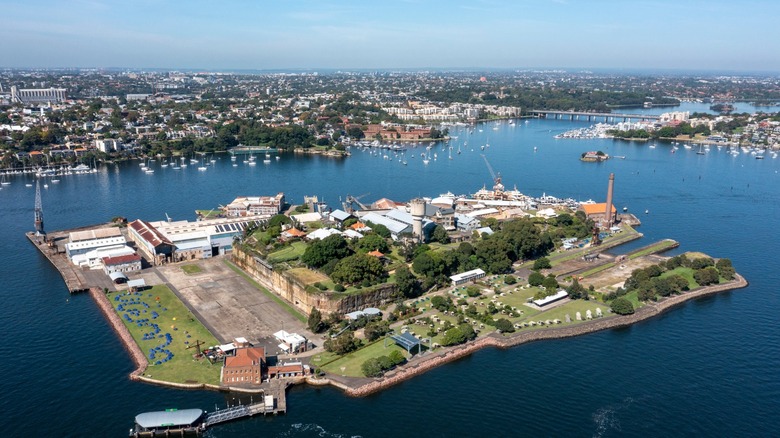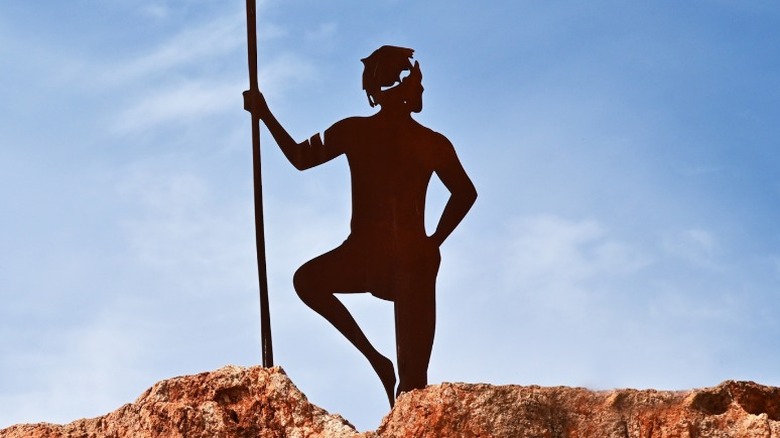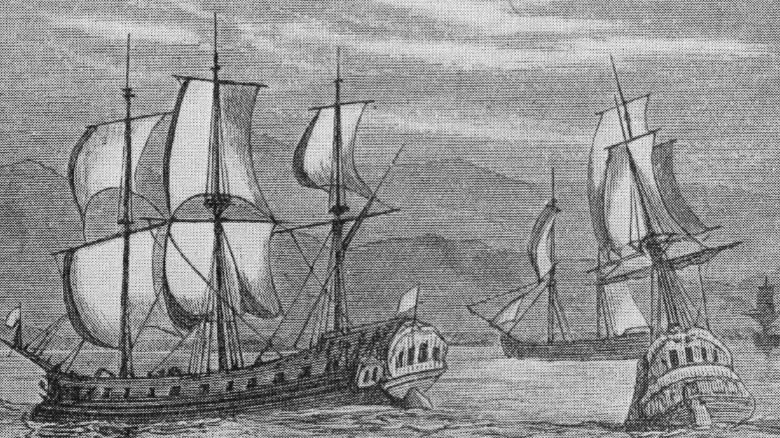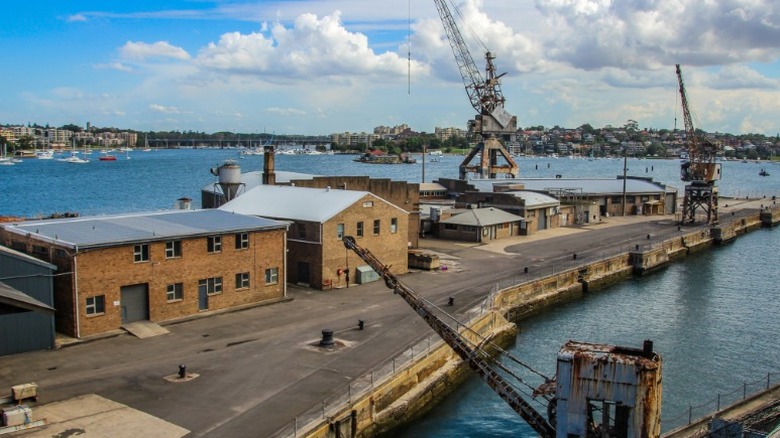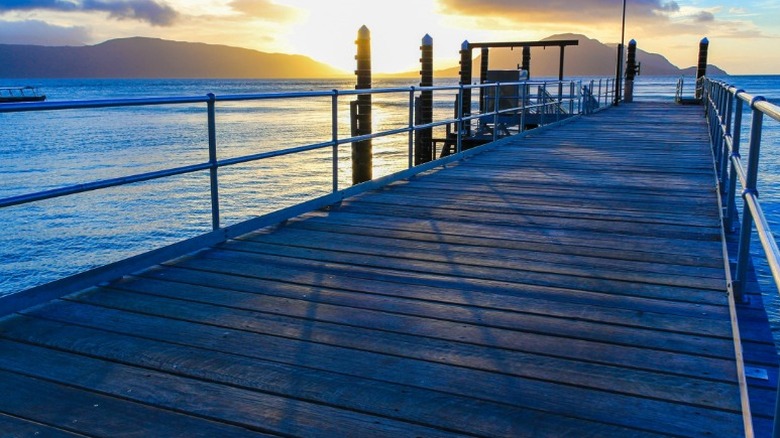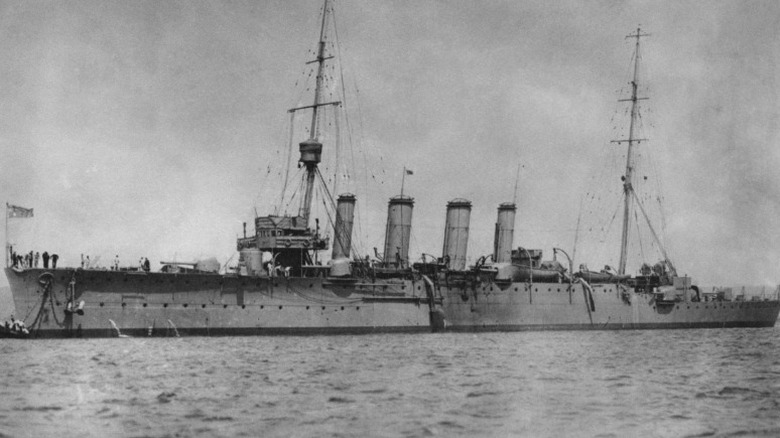The History Of Cockatoo Island, Australia's Alcatraz
In a bay where the Lane Cove and Parramatta rivers meet sits an island deemed worthy of cultural significance for both Indigenous Australians and the British colonizers who had strategic uses of the land. Cockatoo Island made the rolls of the World Heritage List in 2010, joining only a handful of sites Down Under to hold that distinction. In its history, the island has been used for multiple purposes. What began as a penal colony to relieve the overcrowding of nearby prisons evolved into a key location for the shipping industry and later a strategic spot for Allied ships during WWII.
The colonizers who started developing the island in the 19th century transformed it from a wooded knoll into what it is today. Cockatoo Island has structures from all its developmental phases intact today. It's possible to see the prison barracks constructed by the first convicts, but also the places where WWII-era submarines were repaired. Instead of razing old buildings to make way for new ones, the existing ones underwent adaptive reuse, preserving the past while modernizing them for contemporary uses.
Before it became a tourist attraction, Cockatoo Island was home to hundreds of convicts. It was a brutal life for those imprisoned there, as harsh living conditions and backbreaking labor were daily facts of life. A visit to this former forced-labor penal colony might give you an idea of why it is sometimes to referred to as the Alcatraz of Australia.
The island was first used by Australia's Indigenous people
Thousands of years before any Europeans took sail and landed on the Australian continent, the land was occupied by different groups that are recognized as the land's Indigenous peoples. The Eora were the dominant group of Indigenous in that part of the country, establishing settlements along the Parramatta River. Within the Eora (a broad name for the Indigenous folks in that region, given to them by the colonizers) were more than two dozen clans, all of whom spoke the Dharug language. Linguists have revealed that Cockatoo Island was named Wareamah in the native tongue.
Archeological evidence shows that the Eora have inhabited that area for an estimated 65,000 years, giving a great indication that they were the first group to ever set foot on the island. But even though there is plenty of evidence linking the land to past Indigenous inhabitants on the shores of the bay that surrounds Cockatoo Island, none remains on the island itself. This doesn't come as any surprise to researchers, however. The constant geological disruption the island experienced beginning in 1839 likely made any trace of Eora artifacts vanish entirely. That was the year that the Governor of New South Wales, Sir George Gipps, elected to use the island as the home of a new penal colony.
British convicts begin to arrive in the Australian colonies
Crime in Great Britain was soaring in the 18th century. Poverty led to a great increase in illegal acts that ranged from petty to violent, ultimately resulting in mass incarcerations and overcrowded prisons. To ease the swell of convicts within institutional walls, the Crown shipped their convicts off to the shores of North America. This dumping ground was the perfect solution until the colonies there united and shook off royal control in exchange for autonomy.
But the British had other holdings that served as options for the people they considered throwaway. The government loaded ships up with murderers and thieves and sent them sailing to the eastern coast of Australia to establish a penal colony there. After a harrowing 10-month voyage, Captain Arthur Phillip of the HMS Sirius landed in modern New South Wales with a fleet carrying an estimated 700 convicts. After several years of hardship, this colony, largely built from convict labor, began to thrive.
Over the next 80 years, 160,000 more convicts arrived in Australia from England. The British settlements here were built largely on the backs of the men and women sent there for punishment. Everything from brickmaking to logging to agriculture was performed by convict labor. Penal colonies were beginning to pop up in multiple areas, helping the British government create a stronger colonial imprint on land that had — for tens of thousands of years — been settled by Indigenous people.
Cockatoo Island was used as a penal colony beginning in 1839
In time, some of the prisons in the Australian colonies were becoming overcrowded. Sir George Gipps offered up his solution — he got approval to use Cockatoo Island as the location for a new prison. His vision was to take the most troublesome settlers and send them to the island, using the labor of reoffending criminals to build it. Gipps figured that the surrounding water served to make the island prison escape-proof and that the island's accessibility meant that the labor and other convict duties could be easily supervised by the colonial government on the mainland.
Sixty convicts arrived on Cockatoo Island in February and were put to work. The island had no shelters yet, and the inmates were forced to live in tents. The sandstone beneath the island's soil was excavated and used to build structures to store grain for the colony on the mainland. It's thought that these inmates created 20 silos in their first two years on the island, built to store wheat so that future shortages could be averted.
Life in the island penal colony was a difficult one. Sanitation wasn't much of a concern for those in command, resulting in problems with rats, bedbugs, and fleas. Outbreaks of disease weren't uncommon. Making matters worse was the island being placed under the control of Charles Ormsby, who used convict labor for his own personal financial gain. He had solitary confinement cells constructed and was known to be a harsh disciplinarian. He was at last removed after nearly 20 years due to multiple inquiries regarding his corruption.
The island served a dual purpose under its next superintendent
Before Charles Ormsby was relieved of his duties on the island, a civil engineer named Gother Kerr Mann was hired to oversee the construction of the buildings there. In 1947, he became Cockatoo Island's engineer-in-chief, often butting heads with superintendent Ormsby. Perhaps the biggest accomplishment owed to Mann was the construction of the Fitzroy Dock, completed in 1857. The island was now not only a penal colony but also used for the docking of ships. The dual purpose of Cockatoo Island increased the tensions between Ormsby and Mann, a problem that was solved by Ormsby's removal in 1859 and the establishment of Mann as the island's overall superintendent.
Mann's leadership transformed the island's trajectory. For the next 130+ years, Cockatoo Island was an integral part of the Maritime industry. The island was used for shipbuilding beginning in 1870, a year after the penal colony was closed and the inmates moved to other prisons. The industry grew so large, and the location was so strategic that the island became the official dockyard of the Royal Australian Navy in 1913.
During WWII, Cockatoo Island was used to repair damaged vessels for the Allied navies. After the Imperial forces from Japan seized Singapore, Cockatoo Island was the only spot in the south Pacific for repairing large ships. During this era, 400 people worked on the island, repairing an estimated 250 ships and tending to the 750 that docked there.
Cockatoo Island has at least one daring escape story
There are not many prisons in the world that don't have at least one tale of a daring escape. For Cockatoo Island, that story revolves around a fellow named Frederick Ward. Ward was a horse thief that was sent to serve a 10-year sentence on the island. Luck seemed to be on his side as his sentence was reduced to only four years, the result of good behavior. But not long after his release, he found himself in violation of his parole and was sent right back to serve out the remainder of his sentence.
As the story goes, Ward's wife swam to the island and left a file for Ward and another inmate to cut through their chains. Ward and the other convict fled the island by swimming to the mainland through waters reportedly infested with ferocious sharks. From his 1863 prison escape until he died in 1870, Ward was a bushranger (a bandit who robbed miners and other workers) living under the name Captain Thunderbolt. He met his end after being shot by police Constable A.B. Walker.
Today, Cockatoo Island is a popular tourist attraction. The buildings erected by convict labor are still there, as are the relics left behind by the island's time as an important cog in the Maritime machine. It is managed by the Harbor Trust and open year-round for anyone interested in seeing this rich part of Australian history.
